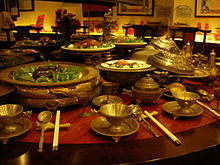- Manchu Han Imperial Feast
-
Manchu Han Imperial Feast 
Manchu Han Imperial Feast displayed at Tao Heung Museum of Food Culture Chinese name Traditional Chinese 滿漢全席 Simplified Chinese 满汉全席 Transcriptions Hakka - Romanization man24 hon55 qion11 qiag5 Mandarin - Hanyu Pinyin mǎn hàn quán xí - Bopomofo ㄇㄢˇ ㄏㄢˋ ㄑㄩㄢˊ ㄒㄧˊ Min - Hokkien POJ buán-hàn tsuân-si̍k Wu - Romanization moe上 hoe去 zie平 zih入 Cantonese (Yue) - Jyutping mun5 hon3 cyun zik6 Japanese name Kanji 満漢全席 Kana まんかんぜんせき Transcriptions - Romaji man kan zenseki Korean name Hangul 만한전석 Hanja 滿漢全席 Transcriptions - Revised
RomanizationManhan jeonseok - McCune-
ReischauerManhan chŏnsŏk Vietnamese name Quốc ngữ Mãn Hán Toàn Tịch Manhan Quanxi, literally Manchu Han Imperial Feast was one of the grandest meals ever documented in Chinese cuisine. It consisted of at least 108 unique dishes from the Manchu and Han Chinese culture during the Qing Dynasty, and it is only reserved and intended for the emperors. The meal was held for three whole days, across six banquets. The culinary skills consisted of cooking methods from all over Imperial China.[1]
Contents
Names
Quite a number of English names have been used to describe the dish combinations.
- Manchu Han Imperial Feast[1]
- Qing Han Imperial Feast
- Manchu Han Feast
- Feast of Complete Manchu-Han Courses
- Man Han Quan Xi
History
Qing Dynasty
When the Manchus conquered China and founded the Qing dynasty, Manchu and Han struggled for power. Kangxi emperor wanted to resolve the disputes, and held a banquet in his 66th birthday. The banquet/imperial meal consisted of Manchu and Han dishes, both groups also attended the banquet together. After the Wuchang Uprising, common people learned about this royal cuisine. The original meal was served in the Forbidden city in Beijing.[1]
Preparation
The meal was prepared comprising six banquets over three days with over 300 dishes. Altogether there are said to have been 196 main dishes and 124 snack dishes, for a total of 320 dishes sampled over three days. Depending on how the dishes are counted with the samples, at the absolute minimum there were 108 dishes.[1] The emperor, after previewing the dishes, gave the feast its present name. The feast was divided into inner-palace and outer-palace banquets; only the imperial family and meritorious officials, including Han officials above the second rank, were invited into the inner-palace banquets. A book from the reign of Qianlong gives a detailed description of the feast and the dishes and ingredients.
The meal
It is said that there were "Thirty-Two Delicacies", referring to the more exotic ingredients used for the banquet. The "Eight Mountain Delicacies" includes such dishes as camel's hump, bear's paws, monkey's brains, ape's lips, leopard fetuses, rhinoceros tails and deer tendons. The "Eight Land Delicacies" includes several precious fowls and mushrooms, and the "Eight Sea Delicacies" includes dried sea cucumbers, shark's fin, bird's nest and others.
Some of the individual names of the dishes within:
- Snowy Palm - bear claw with sturgeon[1]
- Golden Eyes and Burning Brain - bean curd simmered in chicken, duck and cuckoo brains
- Monkey King and Shark - goat brain
- Live monkey brain[2][3]
- Egg tart
Utensils
The utensils, like the food, were also lavish; the majority of utensils were finely crafted bronzeware, and porcelainware in the shape of many animals were designed with mechanisms for keeping the dishes warm throughout the meal. In general the Manchu dishes were first sampled, followed by the Han dishes.
Popular culture
The imperial meal was re-enacted in the movie The Chinese Feast and the TV drama Happy Ever After.
In modern times, the Sintic term "Manhan Quanxi" can be used as an idiomatic expression to represent any feast of significant proportions. As an example, various media outlets may refer to a dinner gala as "Manhan Quanxi", while in China there are also numerous cooking competitions which make use of the aforementioned name,[4] while not specifically referring to the original meaning of the imperial feast. The name is also used extensively in product names in the food industry, such usage evident as brands of sauces and instant noodles by various different companies.
Replicas
The cuisine is extremely rare in China today, and if offered it is by a large margin one of the most expensive meals in the entire Chinese cuisine collection. Even when served, it is done with replacement ingredients, as many of the animals are essentially endangered species. Waiters serving the replicas are required to wear some form of traditional Chinese clothing.
References
Categories:
Wikimedia Foundation. 2010.
